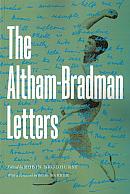The Altham-Bradman Letters
Martin Chandler |Published: 2020
Pages: 125
Author: Brodhurst, Robin
Publisher: Christopher Saunders Publishing
Rating: 4 stars

Although it doesn’t describe the play in any cricket matches, nor chronicle the life of any leading player, I have to say at the outset that this one is a fascinating book, and one which I have much enjoyed reading.
Of the two men who figure in the title one needs no introduction but, certainly in the 21st century, Harry Altham does. He was a decent batsman who made more than fifty First Class appearances on either side of the Great War for, in the main, Oxford University and Hampshire. That said, a career schoolmaster at Winchester, he is better known for his writing, in particular a history of the game that ran to several editions, and his role as an administrator.
That Altham’s history is something of a classic is evidenced by the fact that even the notoriously difficult to please Rowland Bowen praised it. That in addition to his other talents Altham was a skilled negotiator and ambassador is clear from this book, edited by his grandson and another career schoolmaster, Robin Brodhurst.
The first 23 pages of the book are taken up with an, inevitably, affectionate portrait of Altham, although given that everything else I have read about him is unfailingly positive I do not seek to suggest that the familial relationship has significantly clouded Brodhurst’s objectivity.
After that entirely appropriate beginning Brodhurst goes on to set the scene. The game of cricket was not in great shape in the late 1950s. A seemingly immensely strong albeit aging England side had gone to Australia in 1958/59 and been heavily defeated, and in being so had played some uninspiring cricket. The Englishmen had complained bitterly of a battery of Australian bowlers whose actions they questioned, and whilst they were right to do so the manner in which the English media portrayed the problem led to accusations of ‘squealing’.
Suspect bowling actions were, at the time, a worldwide problem and the need to eradicate them recognised by all, but how was that to be done? The fear was that English umpires would, when the 1961 Ashes came round, no ball the alleged Australian transgressors leading to a controversy to rival in its intensity the Bodyline furore of 1932/33.
At the time the Australian and English authorities tried hard to establish some sort of protocol to avoid any risk of confrontation and Altham and Bradman were in the front line of those efforts. The pair knew each other from having met in the early 1950s and it is clear there was a mutual respect there. In the manner of the time their communications were in letter form, and many survive, and it is the reproduction of those, with a few other documents and an excellent and wholly dispassionate commentary by Brodhurst that make up the greater part of this book’s 125 pages.
What I hadn’t really taken on board before was just how far the Australian and English administrators were apart. They, and indeed the rest of the world, recognised what problems had to be addressed, but how that should be done was never really resolved and the letters are a remarkable testament to the diplomatic skills of Altham, and the extent to which Bradman and Australia were frustrated by what they had to deal with.
In the event disaster was avoided, albeit no thanks to the two Boards. The magnificent series in Australia in 1960/61 against Frank Worrell’s West Indians and the fillip that gave to the search for positivity in all aspects of the game helped, but the real boon was that in the run up to 1961 none of the bowlers who had caused so much consternation amongst the England players and their press corps in 1958/59 showed any form at all, and so none were selected for 1961 – crisis averted.
As I stated in opening The Altham-Bradman Letters is a fascinating book, well written and with an excellent foreword by Bob Barber, a man who the reader learns towards the end of the book was a cricketer who Altham held in very high regard and for whom he had high expectations. The book is also beautifully presented by the publisher and comes in two editions. The first has card covers and is priced at a modest £12 plus postage. As an alternative there is a cloth bound limited edition of 60 copies, numbered and signed by Brodhurst and Barber and housed in a handsome slip case – that one is priced at £75 plus postage, but those of us who like that sort of thing will be delighted by the quality of the finished article.






Leave a comment